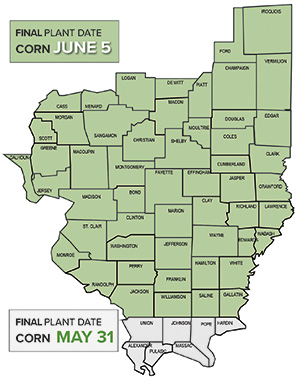Wet Weather Have You in a Holding Pattern?
-
 March 28, 2019
March 28, 2019

Plant Dates
Earliest Plant Date
Once conditions are suitable, it can be challenging to have to wait to fill those seed boxes and start planting. To remain eligible for a replant payment, however, you must not plant before the insured crop’s earliest plant date. Refer to the map below for your county’s earliest plant dates for corn and soybeans.
Final Plant Date
Heavy rainfall, flooding, or just plain bad luck can delay planting. For your crops to be insured under their full protection guarantee or amount of insurance per acre, the crop must be in the ground by the final plant date. The two maps below identify the final plant dates for corn and soybeans in your county.
There is a late planted period – 20 days after your county's final plant date for corn; 25 days for soybeans – during which coverage is reduced. If planting timeliness becomes an issue, contact your local crop insurance agent to fully understand your options.


Prevented Planting
Did factors outside of your control stop you – and farms surrounding you – from planting by the final plant date or within the late planting period? Fear not for your bottom line; your insured acres are covered by prevented plant – included in Revenue Protection, Revenue Protection Harvest Price Exclusion, Yield Protection, and Yield Protection Catastrophic policies.
Failure to plant because of uninsured causes such as lack of proper equipment or labor, or use of a particular production method, is not covered under prevented planting.
Considerations
- Idle acreage will earn an indemnity equal to the factor on the following chart, multiplied by your per acre revenue guarantee.
Crop Factor +5% Buy Up Corn 55% 60% Soybeans 60% 65% Grain Sorghum 60% 65% - Acreage must meet the 20/20 rule. To qualify for prevented planting protection, acreage must be the lesser of 20 acres or 20% of acreage in the insured crop unit; prevented planting acres do not need to be contiguous.
- Maximum eligible prevented planting acres are determined separately by crop based on the history from the four most recent crop years.
Each prevented plant situation is different, so be sure to talk with your crop insurance agent as soon as possible to ensure you're covered.
Replanting
Before getting back in the field when you have insured acres to replant, contact your local agent to submit a loss AND speak with an adjuster. Failure to do so may result in a denial of the replant payment that comes with multi-peril crop insurance (MPCI) policies like Revenue Protection, Revenue Protection Harvest Price Exclusion, and Yield Protection.
RMA Replanting & Final Plant Date FAQs & RMA Double Cropping and Practical to Replant FAQs
Considerations
- Acreage must meet the 20/20 rule. To qualify for replant benefits, acreage to be replanted must be the lesser of 20 acres or 20% of the insured crop unit.
- Damaged acres must be replanted within 10 days after your county’s final planting date, unless the Approved Insurance Provider deems the acres aren’t practical to replant due to circumstances that wouldn’t allow the crop to reach maturity.
- MPCI replant payments are calculated using a given bushel per acre, multiplied by the 2019 actual projected price for each crop.
- Corn
- 8 bushels per acre x $4.00 = $32.00 per acre
- Soybeans
- 3 bushels per acre x $9.54 = $28.62 per acre
- Grain Sorghum
- 8 bushels per acre x $3.94 = $31.52 per acre
- Corn
- Additional indemnities will be provided if supplementary replant endorsements were purchased as part of your MPCI policy. Contact your agent for specific endorsement rules as they vary by insurance company.
Contact your local FCI crop insurance agent if you believe any of these circumstances apply to your farm and with any questions regarding your policies this spring.
-
Tag Cloud
rural marketplace investment Interest Rates patronage employees appraisals KOHL-laborations land sales scholarships cash flow Focus on Farming calendar balance sheet 4-H Weather Outlook Community Improvement Grants Land Values Education FFA Essentials Newsletter Dr David Kohl Land Classes Financials Auction Results FOMC farmland auctions Farm Credit College Weather FreshRoots


